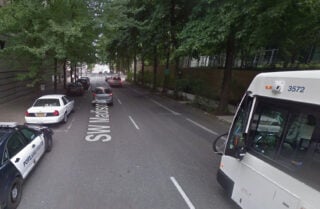
Physical separation is to bicycling what reliability is to transit. If we don’t have it, the masses will never switch from driving and our transportation system will never reach its potential.
That’s why an idea for a “pop-up” bus-only lane is worthy of your attention.
Our friends at the all-volunteer Portland Bus Lane Project have pitched an idea to Better Block PDX that would reconfigure SW Madison Street between 5th and the Hawthorne Bridge. Their idea comes in response a request for proposals that Better Block launched back in July.
PBLP was hatched in May by a group of transit advocates that are frustrated with how auto-congestion during peak hours is killing bus reliability. Their solution is to create dedicated bus-only lanes which they see as an inexpensive way to prioritize mass transit and improve bus reliability while getting more people to their destinations on time.
Their proposal is currently being vetted and considered by Better Block and they’ve given me permission to share it with you.
The proposal
Portland Bus Lane Project’s idea is to create a week-long, temporary pop-up dedicated bus lane on SW Madison from 5th Avenue eastbound to the Hawthorne Bridge. They’ve targeted the Hawthorne because it’s the busiest transit bridge in Portland (with about 12,000 daily passengers) and it falls victim to gridlock every day during the PM peak.
Five different bus lines converge on the Hawthorne via Madison and they serve about 12,000 daily passengers. The street is also a major city bikeway used by about 3-4,000 eastbound bicycle riders a day. And according to City of Portland data about 7,600 motor vehicle users drive eastbound on the bridge during on a normal weekday. All this traffic means buses coming from the transit mall on SW 5th and 6th often must wait through several light cycles just to go a few blocks. “Delays approaching the Hawthorne Bridge have a ripple effect throughout the transit system as these lines remain delayed until the end of their trip,” reads the Portland Bus Lane Project proposal. “These delays cause riders to miss connections and prevent transit from being a reliable option.”
Advertisement
The current cross-section has three lanes between 5th and 4th — two are multi-use lanes and one (on the left side) is an auto parking lane. Starting at 4th the cross-section includes a curbside bicycle-only lane on the right. Portland Bus Lane Project wants to try something different: Make the parking lane a multi-use lane, convert one of the multi-use lanes into a bus-only lane, and extend the bike-only lane all the way to 5th. The design would also prohibit right turns for motor vehicles the length of the project.
Here’s the current cross-section, followed by the proposed new one:
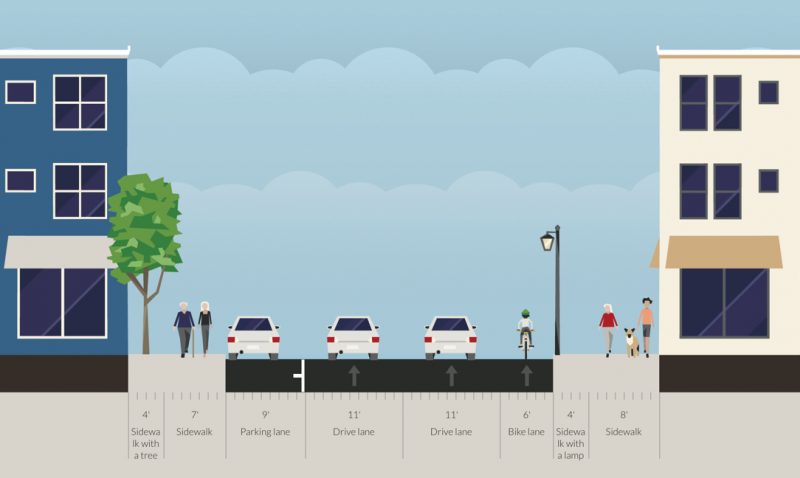
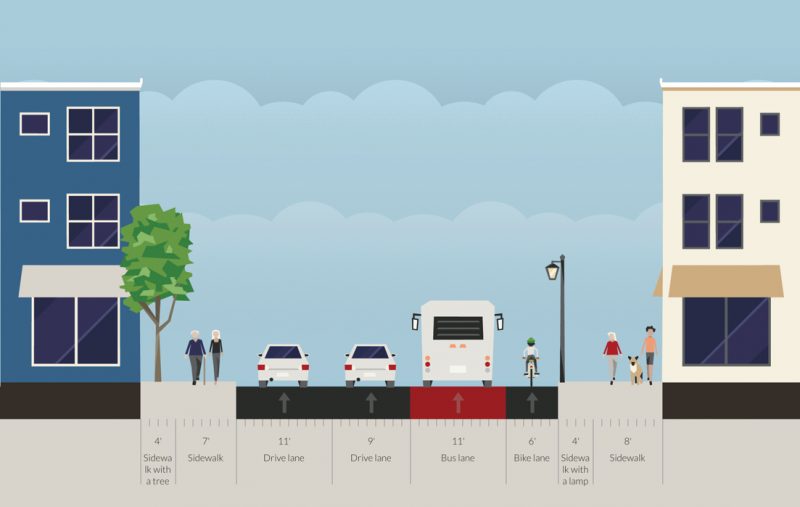
Keep in mind that beyond better transit efficiency and reliability, this design could be safer due to the prohibition of right turns from Madison. You might recall that Kathryn Rickson was killed at Madison and 3rd back in 2012 when a man turned his large truck across her path.
Also note that while not in the official proposal, the founder of Portland Bus Lane Project, Alan Kessler, says he will push for bus islands in the final project. The islands would be between the bike and bus lane in order to prevent leap-frogging that occurs when bus operators swing into the bike lane to service curbside stops. Kessler says if they can’t get islands past city engineers, they’ll try combining the bus and bike lanes into a shared environment. That’s what these pop-ups are all about — experimentation.
What’s next
Better Block is currently reviewing this and other proposals and the chosen projects should be ready for implementation by this spring. Bus Lane Project members are eyeing the Southeast Sunday Parkways in May as a potential time to try it out.
As for the future, project organizers are eager to try other spots if this works out on Madison. “We hope this project serves as as a proof of concept that temporary and permanent bus lanes are feasible, effective, and efficient,” they say. “If the concept proves as successful in Portland as it has elsewhere, we plan to use this data to advocate for additional bus lanes throughout the city.”
We’ve seen how effective these temporary “pop-up” projects can be. Better Block can be credited with them leading to real and permanent changes on SW 3rd (the new buffered bike lanes and plaza near Burnside) and eventually Better Naito. By simply giving something like this a try it allows the city to envision possibilities that would otherwise only materialize after years of process and hand-wringing. As Portland grows and we fall further behind on our climate change and transportation goals, we must be willing to try new things.
And for what it’s worth, better bus transit has considerable political momentum at the Bureau of Transportation right now. PBOT is pushing an Enhanced Transit Corridors program that does exactly what Portland Bus Lane Project wants to do on Madison: Give buses more priority so they can operate free from congestion. At an invite-only panel discussion last week (more on that in a separate post), PBOT’s Policy, Planning and Projects Group Manager Art Pearce said, “Unless we make hard decisions around how our roads are going to function, prioritizing transit, we are leaving TriMet stuck in more and more traffic.”
Is this something worth trying? Let us know what you think.
— Jonathan Maus: (503) 706-8804, @jonathan_maus on Twitter and jonathan@bikeportland.org
Never miss a story. Sign-up for the daily BP Headlines email.
BikePortland needs your support.



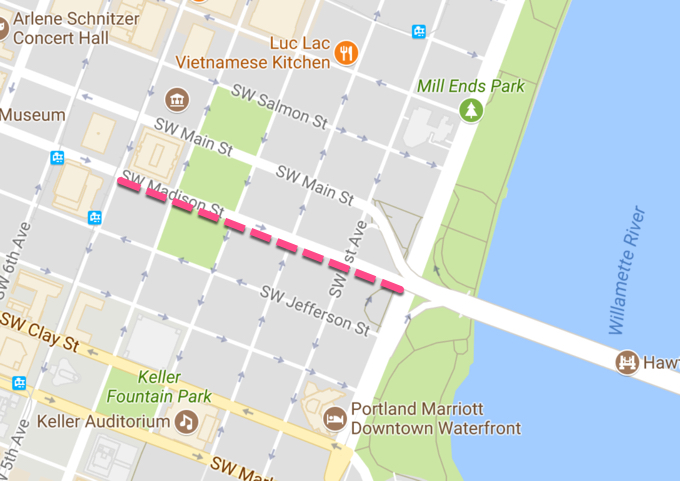
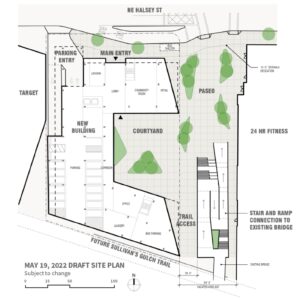
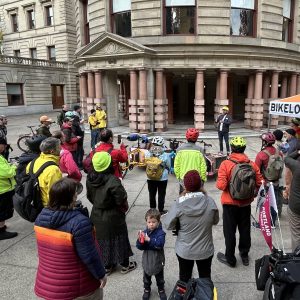
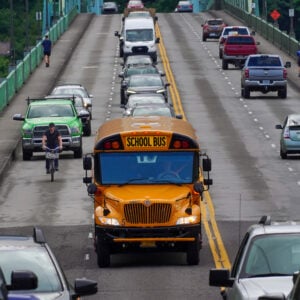

Thanks for reading.
BikePortland has served this community with independent community journalism since 2005. We rely on subscriptions from readers like you to survive. Your financial support is vital in keeping this valuable resource alive and well.
Please subscribe today to strengthen and expand our work.
This is a great idea. I would prefer the bike lane to be switched with the bus lane so that bus runs along the curb. A green box at Naito would let the bikes move to the right before getting on the bridge. The floating bus stop islands introduce a lot of ped/bike conflicts
This setup currently exists at SE Grand and Hawthorne, and can also create a backup of buses at peak hours. Quite often only one of a number of buses can barely squeeze through after waiting for all the bikes and cars to pass. If the bikes are already on the right, that crossover and subsequent backup can be avoided altogether.
Then there is the pedestrians that want to board those buses having to cross that bike lane…
I think the bus should run along the curb to avoid this. This seems much safer and simpler than floating ped islands.
At face value, I agree this is a good idea; I just worry about all the compromises necessary to make this permanent.
Most of the time these compromises are for the convenience for motorized users and result in decreased safety for non-motorized users.
What happened to the idea of making the outside lanes across the bridge bus only during rush hours?
I think most of the congestion this fix is trying to solve is due to temporary closure of the Morrison Bridge.
I am not a fan of increasing bike vs. bus conflicts in the curb lane. They need to get creative on the bike lane location and figure out how to make proposals like this where the various buses will not constantly be in some state of blocking the bike lane.
If this becomes permanent, floating bus stops would fix the bike/bus conflicts. This would also prohibit all right turns, which improves safety.
Prohibiting all right turns is going to be a very hard thing to sell to City Council, the PBA, the O’s editors, etc. Just sayin’…
we may get two new city councilors this election cycle…
It would really only affect 3rd and 1st. 3rd dead-ends just a few blocks south, and 1st isn’t that busy. I don’t see the change disrupting traffic too much.
And drivers
The last turn before the bridge is a right turn. I understand the reasons for the design and support it in principle but there are going to be some rash illegal turns if this is the design. Maybe do something with signal timing? The short blocks don’t allow much room for queuing either. As a demonstration project it might be unsuccessful because of the long learning curve for that kind of change.
I rarely see vehicles making that left, so I suspect demand is low. There might be other routes drivers could take.
Left? The last turn before the bridge is a right. Anyone wanting to go south from Madison would have to make a left on 2nd and double back on either SW 1st or SW 3rd. Most of them will be in the wrong lane. This maneuver would not immediately show up on driving apps, it’s counter-intuitive, and the difficulty is compounded by the construction site for the new Multnomah County Courthouse.
Dedicated bus lanes are great. If we’re doing a demonstration project let’s make one that has a chance of success.
Why not put the bus in the right-side curb lane, and move the bike lane immediately to the left? That would eliminate the leapfrogging without the need for permanent islands. It would also line cyclists up with the bike lane leading onto the Hawthorne Bridge.
I think that this is a good idea. When I was commuting by bus to/from downtown, most of the trip from SW Harrison and SW 2nd to North Portland was sitting waiting for lights in the downtown area (getting on where I did always enabled me to have a seat, so I would open a book and tune out for the trip).
I think that the city should seriously consider getting rid of all on street parking between 6 a.m. and 7 p.m. Monday to Friday and make people park in parking garages. The city should also restrict the amount of parking that new buildings can include. When I worked downtown the company I worked for gave a substantial number of employees free parking as a perk – that should be taxed as a fringe benefit based on the current price of monthly parking downtown ($210 per month).
Yes. Let’s get it moving.
It’s kind of ridiculous how we’ve got to deliberate for 8 months about whether it’s “worth trying,” as if this kind of thing has never been done before and isn’t literally guaranteed to make the bus go faster. Do it! Do it now!
The parking lane between fourth and third is for enforcement vehicles, isn’t it? What other parking would they displace?
Would love! The idea that a lane is given up for parking cars on that street, with space at such a premium– pretty ridiculous when you think about it.
Not totally ridiculous when you consider the bridge only has two lanes.
What about car traffic turning west from Naito?
While Testifying in favor of the Growing Transit Communities report, which Council unanimously approved today, both Commisionor Fish and Mayor Wheeler expressed significant interest in bus only lanes. I’m pretty sure, assuming it is affordable, Fritz, Eudaly and Saltzman are supportive as well if it increases reliability and rapidity of bus travel.
This is a great idea.
“If we don’t have it [physical separation], the masses will never switch from driving and our transportation system will never reach its potential.” – JM
With such a statement, that borders on being a religious doctrine, any exception in any American context disproves it. Consider Davis, CA of the 1970’s and early 1980’s. It had nearly no physical separation (a mile of bike path connected to the UC campus and a bit of disjointed bike paths in the north central area were pretty much all there was). Somehow, this city of 50k managed to get pretty much everyone on bikes. Bikes outnumbered cars by huge margins all over the city.
How could that be? Simple, the cops lived inside the city limits and followed a zero-tolerance approach to traffic law. That not only made cycling seem much safer, it made driving much slower and increased the hassle factor of driving enough to tip people over to riding.
Sadly, they did the rest of the experiment and dropped the traffic law enforcement. That saw bike use in the city plummet to less than a fifth of its peak in spite of many miles of separated facilities being built.
Note that even the cities so loved by those who advocate endlessly for separation also do extensive regulation of motorists that we don’t do that amounts to a sort of traffic law enforcement. Maybe we should look at emulating success rather than placing faith in pretty concrete.
I think you’re perhaps reading too much into what was just an attempt to write an engaging lede. I actually have a very open mind about bike infrastructure and am open and supportive of all types of facilities. That being said, I do feel that physical separation in many cases and places is indeed essential to get people to ride in Portland in 2017. Davis is an outlier IMO. It’s a tiny college town which is much different than a major city – or even a minor city – like Portland.
how did a college town full of students get so many people on bicycles during a bicycling boom? really?
With some more efficient street use, the official-use spaces on the left could all be re-accommodated leaving plenty of room for a bus lane:
-Move the police parking between 3rd and 2nd around the corner onto 2nd between Main and Madison. Increase amount of spaces there by eliminating the left of 3 lanes on SW 2nd and convert parallel parking to angled. That block of 2nd should be able to do without a third lane as 2nd is two lanes in the previous block, is not a through street from the south, and the traffic signals limit the amount of traffic that can get onto it.
-Move the police or parking enforcement vehicle parking that’s between 3rd and 4th to what’s now the bus zone on 3rd at Madison. I’m pretty sure that bus zone is from when 3rd and 4th Aves were the main transit spine during Portland Mall construction. That’s long since over and the stop now serves just one bus line, Line 6. Instead, have it stop on the curb extension that’s on the far side of the intersection, possibly relocating the bike racks there to along Madison or some other place to make room.
-Relocate the 15-minute parking that’s between 4th and 5th to SW Main or other nearby streets. While they may have to displace others, seeing buses leave downtown quicker could entice the same or more number of drivers who are now using downtown parking spaces to take transit instead.
Overall, in the PM peak it is now possible to have two or more buses on the same route stuck within a few blocks of each other. If travel was faster, following buses could make it to what’s now their leader’s position and cover the leader’s trip. It would take less buses to maintain a loop of vehicles X minutes apart. Given that some operators/buses make only one or two trips, TriMet is loosing possibly hundreds of thousands a year on bus runs that essentially only exist to sit in the traffic congestion on SW Madison.
The bike lane and path along SW Moody has transit islands, where pedestrians must cross at least one lane of bikes to reach the sidewalk.
I have never once seen a conflict between bikes and walkers.
Exactly. Transit islands are a proven best-practice, both for user safety and efficient transit operation.
Is there actually room for a bus lane and floating islands? The islands will require 4-5 ft, no?
don’t remove parking… convert it to a protected bike lane if you want it gone… but just take a lane from cars and give it to buses and let commuters deal with even worse auto traffic or find alternate transport…
this isn’t Vision Zero compatible…